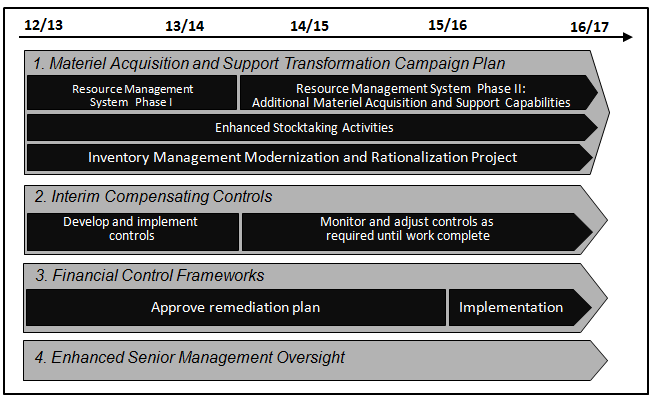PACP Committee Report
If you have any questions or comments regarding the accessibility of this publication, please contact us at accessible@parl.gc.ca.
GOVERNMENT
RESPONSE TO THE 14TH REPORT OF THE Recommendation: That by September 30, 2013 the Department of National Defence provide the Standing Committee on Public Accounts with a plan, including specific initiatives and timelines, of how it intends to improve the proper recording and valuation of its inventory and asset-pooled items. The Government of Canada appreciates the work of the Standing Committee on Public Accounts and the Office of the Auditor General to address the issue of inventory management at National Defence. The Government of Canada supports the recommendation of the Committee and remains committed to continually improve upon the way it does business to achieve efficiencies, ensure transparency and accountability, and ensure the effective stewardship of public resources in line with Canadians’ expectations. National Defence is aware of the importance of improving its inventory management practices and is committed to addressing the challenges identified by the Standing Committee on Public Accounts to more accurately account for the large volume of inventory and asset-pooled items it controls. That is why National Defence has adopted a deliberate, integrated and systematic approach to improve its inventory management practices. Key components and timelines associated with this plan include: 
1. Materiel Acquisition and Support Transformation Campaign Plan The Materiel Acquisition and Support Transformation Campaign Plan will allow National Defence to develop an accurate picture of its inventory holdings and maintain accurate records going forward through: 2. Interim Compensating Controls As it will take some time before the full impact of the Materiel Acquisition and Support Transformation Campaign Plan takes effect, National Defence places a high priority on the continued implementation of interim compensating controls over the course of 2013/14, in line with the advice of the Auditor General. To ensure that quantities recorded for inventory and asset-pooled items reflect the actual quantities in stock, that accurate pricing is updated on a timely basis and that processes and procedures are in place to maintain the integrity of price data, National Defence will: 3. Financial Control Frameworks National Defence is developing financial control frameworks for inventory and capital assets (including asset-pooled items) as part of its work to implement the Treasury Board policy on internal control. Once completed, financial control frameworks will ensure that National Defence’s reporting in the Public Accounts of Canada is verified by a rigorous system of checks and balances monitored by departmental management and reviewed by auditors, to ensure the integrity and reliability of reporting. This project is targeting completion in 2016/17. 4. Enhanced Senior Management Oversight Initiatives to improve inventory management are integral to ongoing defence renewal activities. National Defence’s senior leaders will continue to oversee the implementation of these renewal efforts. For instance, the Deputy Minister and Chief of the Defence Staff co-chair the Defence Renewal Executive Committee which will oversee implementation of efforts to improve inventory management. The Deputy Minister also oversees this work in his capacity as the chair of the department’s Investment and Resource Management Committee, supported by a dedicated Assistant Deputy Minister-level committee which reviews progress of the overall implementation of the Materiel Acquisition and Support Transformation Campaign Plan. Conclusion When taken together, the full implementation of National Defence’s Materiel Acquisition and Support Transformation Campaign Plan, interim compensating controls and financial control frameworks, combined with enhanced senior management oversight, will help to ensure that inventory and asset-pooled items are accurately quantified, priced and accounted for in a timely manner. This will ensure the proper stewardship of public resources, as well as provide the senior leadership at National Defence with timely and accurate information to support effective and efficient operational decision making. |